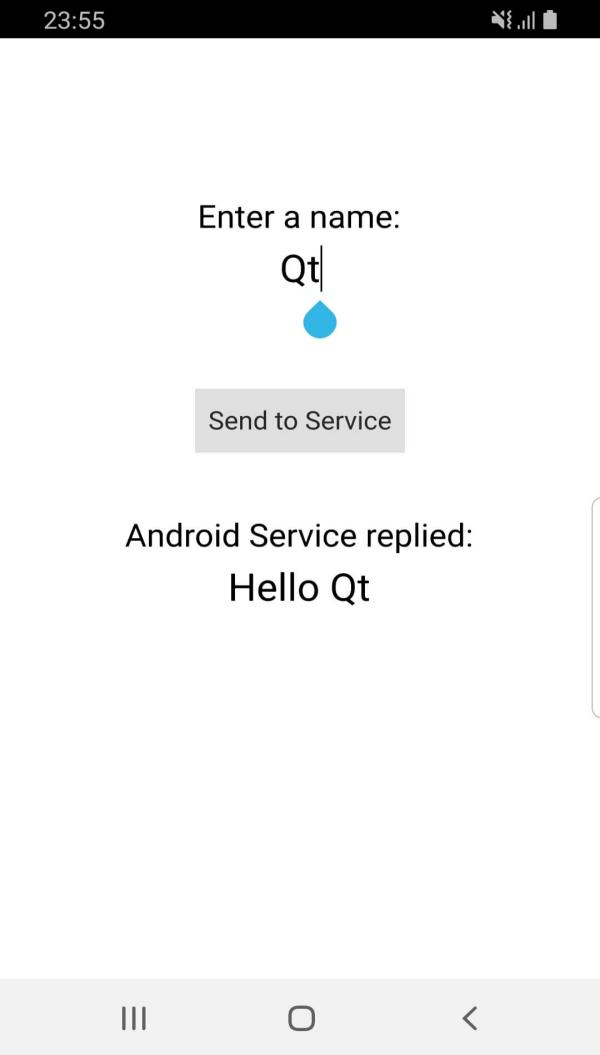Demonstrates how to run an Android service in a separate process using the same lib file, and how to communicate between the service process and the main process using Qt Remote Objects.

This example demonstrates how to create and run an Android service in a separate process from the main application process, and then exchange data between QML/C++ and the Java service using Qt Remote Objects .
When clicking the
Send to Service
button, the name entered in the QML view, Qt, in this case, is sent to the Android service. Then, the service replies back with a message
Hello Qt
which is printed in the QML view.
要运行范例从 Qt Creator ,打开 欢迎 模式,然后选择范例从 范例 。更多信息,拜访 构建和运行范例 .
To start a service in its own process, you can extend the
QtService
class for your service. Extending
QtService
allows the service to load the necessary Qt libraries used for Qt, like
Qt Remote Objects
libraries.
Start by creating the Java service class. The following class extends
QtService
and acts as your service entry point:
package org.qtproject.example.qtandroidservice;
import android.content.Context;
import android.content.Intent;
import org.qtproject.qt5.android.bindings.QtService;
import android.util.Log;
public class QtAndroidService extends QtService
{
private static final String TAG = "QtAndroidService";
@Override
public void onCreate() {
Log.i(TAG, "Creating Service");
super.onCreate();
}
@Override
public void onDestroy() {
Log.i(TAG, "Destroying Service");
super.onDestroy();
}
}
This class can have any logic you want using Java code. However, you don't need any logic to communicate with Qt as that will be done using Qt Remote Objects.
To be able to use the service, it must be declared in the
AndroidManifest.xml
file as follows:
<service android:process=":qt_service" android:name=".QtAndroidService">
<!-- Application arguments -->
<meta-data android:name="android.app.arguments" android:value="-service"/>
<!-- Application arguments -->
<meta-data android:name="android.app.lib_name" android:value="-- %%INSERT_APP_LIB_NAME%% --"/>
<meta-data android:name="android.app.qt_sources_resource_id" android:resource="@array/qt_sources"/>
<meta-data android:name="android.app.repository" android:value="default"/>
<meta-data android:name="android.app.qt_libs_resource_id" android:resource="@array/qt_libs"/>
<meta-data android:name="android.app.bundled_libs_resource_id" android:resource="@array/bundled_libs"/>
<!-- Deploy Qt libs as part of package -->
<meta-data android:name="android.app.bundle_local_qt_libs" android:value="-- %%BUNDLE_LOCAL_QT_LIBS%% --"/>
<!-- Run with local libs -->
<meta-data android:name="android.app.use_local_qt_libs" android:value="-- %%USE_LOCAL_QT_LIBS%% --"/>
<meta-data android:name="android.app.libs_prefix" android:value="/data/local/tmp/qt/"/>
<meta-data android:name="android.app.load_local_libs_resource_id" android:resource="@array/load_local_libs"/>
<meta-data android:name="android.app.load_local_jars" android:value="-- %%INSERT_LOCAL_JARS%% --"/>
<meta-data android:name="android.app.static_init_classes" android:value="-- %%INSERT_INIT_CLASSES%% --"/>
<!-- Run with local libs -->
<!-- Background running -->
<meta-data android:name="android.app.background_running" android:value="true"/>
<!-- Background running -->
</service>
The important parts of this service declaration are the
arguments
and
lib_name
parts. Those will ensure that the service is run by executing the lib file of the main activity with the argument
-service
:
<!-- Application arguments -->
<meta-data android:name="android.app.arguments" android:value="-service"/>
<!-- Application arguments -->
<meta-data android:name="android.app.lib_name" android:value="-- %%INSERT_APP_LIB_NAME%% --"/>
Since the same
.so
lib file is being used for the application and the service, you need to handle both scenarios in the
main()
function. No arguments are provided to start the main application, and therefore you must add the following in the
main()
函数:
if (argc <= 1) {
Then calling the following function starts the service:
void startService() { QAndroidIntent serviceIntent(QtAndroid::androidActivity().object(), "org/qtproject/example/qtandroidservice/QtAndroidService"); QAndroidJniObject result = QtAndroid::androidActivity().callObjectMethod( "startService", "(Landroid/content/Intent;)Landroid/content/ComponentName;", serviceIntent.handle().object()); }
QAndroidService is used to create the service process. The main .so lib file will be called with an argument to start the service if you add the following code:
} else if (argc > 1 && strcmp(argv[1], "-service") == 0) {
要使用
Qt Remote Objects
, define a
.rep
文件:
class QtAndroidService {
SLOT(void sendToService(const QString &name));
SIGNAL(messageFromService(const QString &message));
}
定义
.rep
source and replica file in your project
.pro
file as follows:
REPC_SOURCE += ../common/qtandroidservice.rep REPC_REPLICA += ../common/qtandroidservice.rep
Then define the class used by Qt Remote Objects, which has a
sendToService()
slot and a
messageFromService()
signal:
#include "rep_qtandroidservice_source.h" class QtAndroidService : public QtAndroidServiceSource { public slots: void sendToService(const QString &name) override { emit messageFromService("Hello " + name); }; };
Include the class in the previous snippet in
main.cpp
:
#include "rep_qtandroidservice_replica.h"
Now, inside the service handling part, create the QRemoteObjectHost node:
QRemoteObjectHost srcNode(QUrl(QStringLiteral("local:replica")));
QtAndroidService qtAndroidService;
srcNode.enableRemoting(&qtAndroidService);
Then, in the application handling part, create the client node and connect it to the source node created in the service and connect it to the QML view:
QRemoteObjectNode repNode;
repNode.connectToNode(QUrl(QStringLiteral("local:replica")));
QSharedPointer<QtAndroidServiceReplica> rep(repNode.acquire<QtAndroidServiceReplica>());
engine.rootContext()->setContextProperty("qtAndroidService", rep.data());
bool res = rep->waitForSource();
Q_ASSERT(res);
rep->sendToService("Qt");
Then, add a Connections element to watch for the incoming messages from the service:
Connections {
target: qtAndroidService
function onMessageFromService(message) {
pongText.text = message
}
}
And set the
onClicked
for the sending button to:
onClicked: qtAndroidService.sendToService(pingText.text)
另请参阅 Android Service with Qt Remote Objects , Android 服务 , Qt for Android ,和 Qt Android Extras .